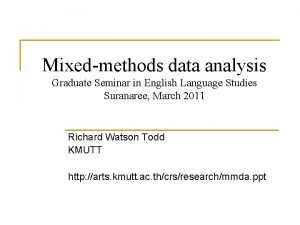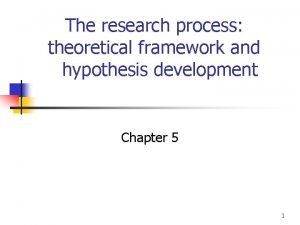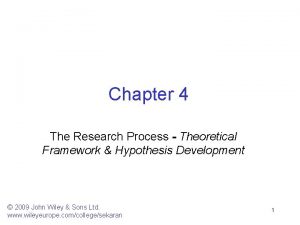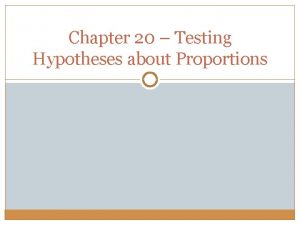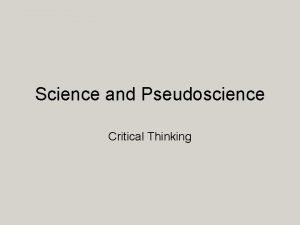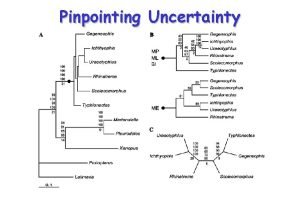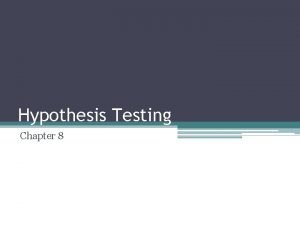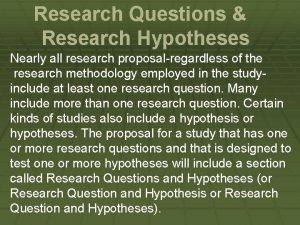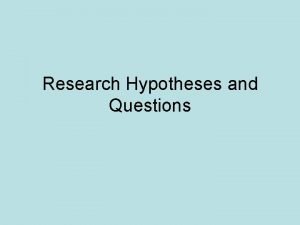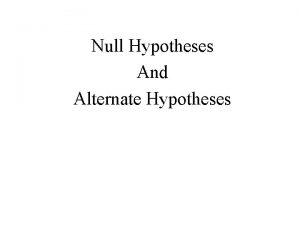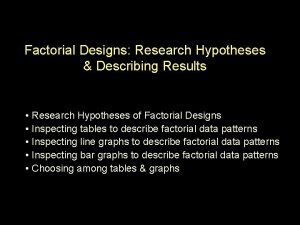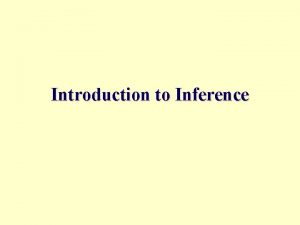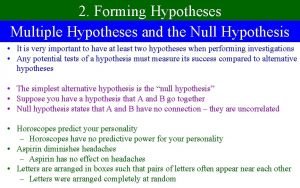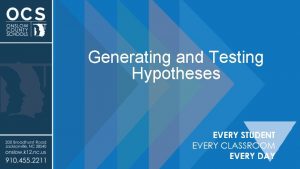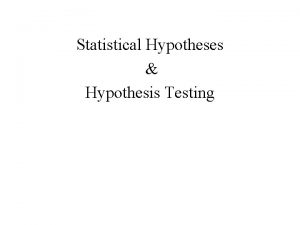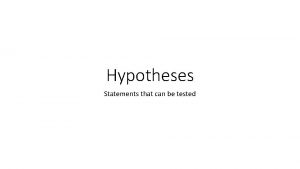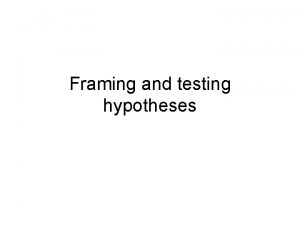Research Questions Research Hypotheses Nearly all research proposalregardless












- Slides: 12

Research Questions & Research Hypotheses Nearly all research proposal-regardless of the research methodology employed in the studyinclude at least one research question. Many include more than one research question. Certain kinds of studies also include a hypothesis or hypotheses. The proposal for a study that has one or more research questions and that is designed to test one or more hypotheses will include a section called Research Questions and Hypotheses (or Research Question and Hypothesis or Research Question and Hypotheses).

Research Questions Research begins with the development of a research problem. From this problem one or more research questions are generated. Research questions relate to the study’s purpose; they state, in question from, the basic issues to be addressed by the study. Research questions can be answered by either or both qualitative and/or quantitative methodologies.

Qualitative methodology is used, there is no statistically testable hypothesis; the research question requires a response that is essentially descriptive. Quantitative methodology is used, there are one or more statistically testable hypotheses derived from the research question; the research question requires a response that results from the statistical testing a hypothesis.

Hypotheses are the basic tools of quantities research. The hypotheses is a tentative, intelligent guess-an assumption-posited for the purpose of directing the research’s thinking toward the solution of the research problem, it is a tentative proposition set forth as a possible explanation of an occurrence or a provisional conjecture to assist in guiding the investigation of a problem; it is a reasonable and logical conjecture; it is an educated guess. Although many terms are used to describe various types of hypotheses, only three major types are discussed here: null hypotheses; non-directed hypotheses; & directional research hypotheses.

Null Hypotheses A null hypothesis states that no statistically significant relationship exists between the variables studied or that no statistically significant difference exists between the experimental treatments. More specifically, a null hypothesis postulates that there is no statistically significant relationship or difference between phenomena that occur by pure chance and the statistically evaluated behavior of the data as they have been observed by the researcher. If the relationship or a difference does occur, and the magnitude of that relationship or difference is such as to exceed the possibility of its having been caused by random error or pure chance, the null hypothesis is rejected. This comparison of observed data with expected results of normative values is called “testing the null hypothesis. ” Thus, the testing of the null hypothesis involves nothing more than a statistical comparison of the data from two situations-the mathematically ideal and the real, the expected and the obtained.

Two examples of null hypotheses are: - There is no statistically significant relationship between the intelligence and reading achievement of elementary school students. - There is no statistically significant relationship between the reading achievement of elementary school students who have received traditional and computer-assisted reading instruction and the reading achievement of elementary school students who have received only traditional instruction.

Non-Directional Research Hypotheses It states that a statistically significant relationship exists between the variables studied (but does not state the expected direction of the relationship) or that a statistically significant difference exists between the experimental treatments (but does not state the expected direction of the difference).

Two examples of non-directional hypotheses are: - There is a statistically significant relationship between the intelligence and reading achievement of elementary school students. - There is a statistically significant relationship between the reading achievement of elementary school students who have received traditional and computer-assisted reading instruction and the reading achievement of elementary school students who have received only traditional instruction.

Directional Research Hypotheses It states that a statistically significant relationship exists between the variables studied (and states the expected direction of that relationship) or that a statistically significant difference exists between the experimental treatments (and states the expected direction of the difference).

Two examples of directional hypotheses are: - There is a statistically significant positive relationship between the intelligence and reading achievement of elementary school students. The reading achievement of elementary school students who have received traditional and computer-assisted reading instruction is significantly greater than the reading achievement of elementary school students who have received only traditional instruction.

Four Criteria for Good Hypotheses 1 - State an expected relationship between two or more variables. 2 - Be testable. 3 - Be worthy of testing. 4 - Be brief as possible consistent with clarity.

Recommendations for designing good hypotheses 1 - Be testable by available techniques. 2 - Be related to a body of theory. 3 - Have an empirical referent. 4 - Be specific. 5 - Be conceptually clear in terms of common definitions.
 Examples of mixed methods research
Examples of mixed methods research Examples of null hypothesis
Examples of null hypothesis Examples of hypothesis in research
Examples of hypothesis in research At what age are nearly all bones completely ossified
At what age are nearly all bones completely ossified Theoretical framework independent dependent variable
Theoretical framework independent dependent variable Framework hypothesis
Framework hypothesis Chapter 20 testing hypotheses about proportions
Chapter 20 testing hypotheses about proportions Theoretical framework and hypothesis
Theoretical framework and hypothesis Ruling out rival hypotheses
Ruling out rival hypotheses Analysis of competing hypotheses template
Analysis of competing hypotheses template Two type of hypothesis
Two type of hypothesis Explain general to specific ordering of hypothesis
Explain general to specific ordering of hypothesis Chapter 19 testing hypotheses about proportions
Chapter 19 testing hypotheses about proportions
